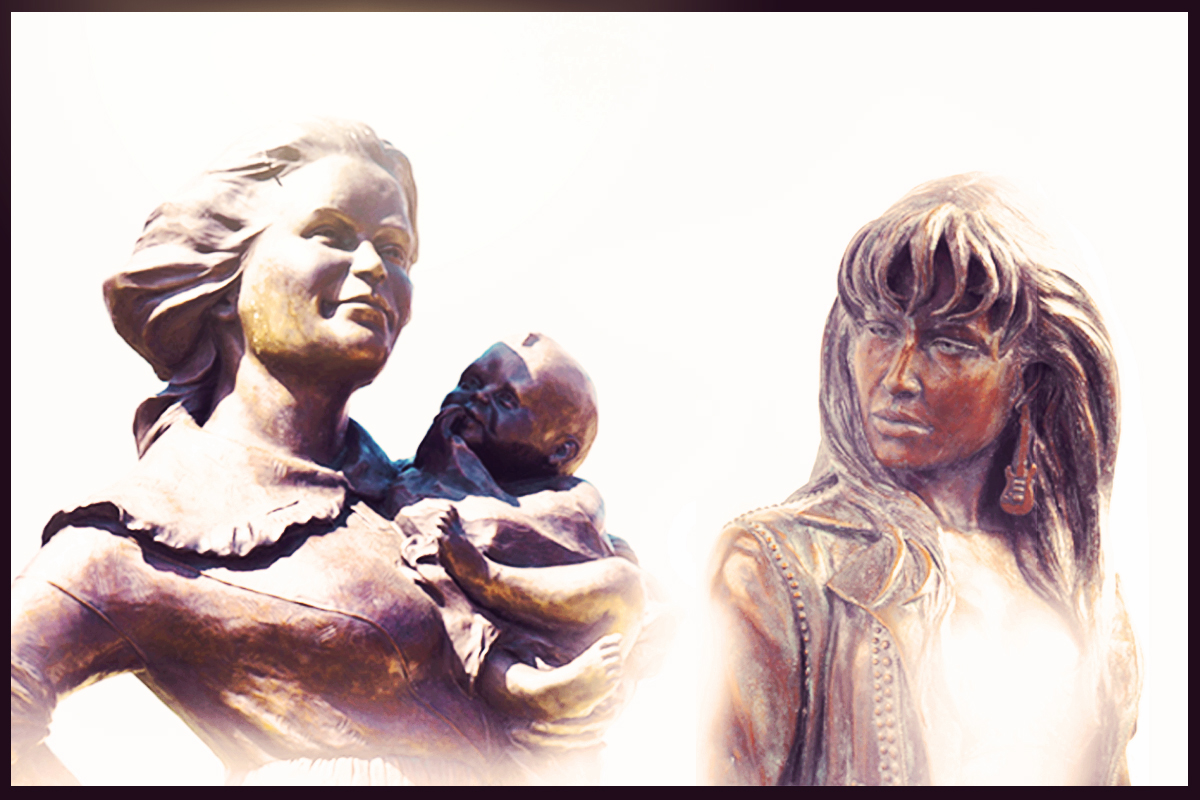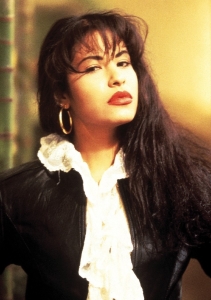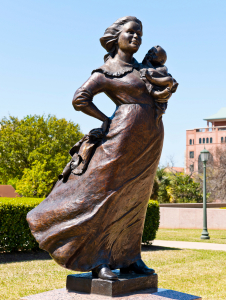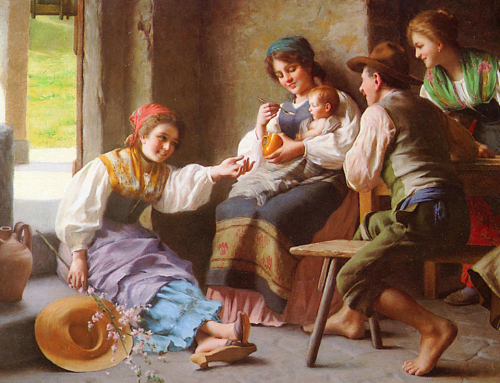Pop Star or Sturdy Pioneer: Who Do Our Girls Aspire to Be?
What kind of woman do our girls aspire to be?
This question is one that has come to my mind often of late as our family has made our way home from Sunday worship in Corpus Christi, Texas. Our weekly route following the church service takes us along the city’s picturesque Shoreline Boulevard which overlooks Corpus Christi Bay. The welcoming breeze coming off the water greets cyclists, joggers, skateboarders, and tourists of all stripes throughout the year who go up and down this scenic strip of the Texas coast.
While there’s much to see within a few-mile radius of this area, including the U.S.S. Lexington, the Texas State Aquarium, and a smattering of blue-masted sailboats docked at the nearby wharfs, the spot with the most visible draw on our way home each week is always the same. It lies at the entrance to the Peoples Street T-Head and is ornamented with a large, white rose which faces the boulevard. Titled the “Mirador de la Flor”—the “Lookout of the Flower”—the memorial is to Selena Quintanilla-Pérez, the local music icon who took the world by storm in the early ‘90s before being viciously murdered in Corpus by one of her managers on March 31, 1995, mere days before the Latin star’s 24th birthday.
Her slaying shocked not only the music world, which had graced Selena with a major Grammy Award the year before, but it sent her hometown of Corpus Christi into convulsions. I remember the event well as I was working then as a part-time DJ for Christian radio station KBNJ. As I drove to the station for my evening shift on April 4, four days after Selena’s death, the roads were lined with cars spackled with white-lettered tributes to the slain Tejano star. Horns honked for miles, and stereos boomed with “Bidi Bidi Bom Bom” and other fan favorites.
Perhaps even more memorable were the numerous impassioned phone calls I fielded that night while manning the station board, requesting that I play one of Selena’s songs over the radio. The phone was ringing off the hook with plea after plea. And when I sought to explain to the callers that we were a Christian station that didn’t play Top 40 music or mainstream Latin hits, they were more than a little perturbed. One even threw me this odd question: “What do you play there—Shakespeare music?”
While this comical anecdote has been the source of many laughs over the years, I have been sobered of late in considering the vision of womanhood Selena represents, as I’ve observed the steady throngs that gather by her statue in Corpus Christi. This revered cultural icon is depicted at the Mirador de la Flor as she was seen in life: at 5’ 8”, clad in form-fitting leather pants with her right leg up in a sultry pose. Her left hand grasps a microphone, and her top is open from collar to waist to reveal a decorative bra and bare mid-riff. This provocative bronze likeness of Selena is anything but modest, yet thousands flock to it yearly to get a look and snap a few photos. In fact, according to the Corpus Christi Caller-Times, Selena’s “statue draws more visitors than any [other] piece of art” in the city.1
The frequent pilgrimages to this landmark are sad to consider because of the message Selena’s figure sends to young girls: that exploiting their beauty is a way to find value and achieve success as a woman. Though Selena was hardly the first American or Hispanic pop star to project this kind of image, you’d be hard-pressed to find another homage in Texas to a venerated female icon that conveys a more bankrupt vision of femininity.
A Virtuous Counterpoint: The Texas Pioneer Woman
In reflecting on this disturbing picture, I was reminded that elsewhere in Texas there stands a stark and virtuous counterpoint to Selena’s seductive portrayal of womanhood. This life-size memorial can be found on the northwest grounds of the State Capitol building in Austin. And while it’s not obscurely located, it draws handfuls of visitors compared to Selena’s Corpus Christi memorial.
It’s the Texas Pioneer Woman Monument, erected in 1998 by the eighth district of the Daughters of the Republic of Texas. Cast in bronze and set atop a red granite pedestal, this homage to womanhood is one we can commend to our girls for the worthy image it represents.
Holding her apron in her right hand and her baby with the left, this pioneer woman looks toward the horizon with a smile of contented confidence. Her baby’s eyes are transfixed on her face, as if soaking in his mother’s warm and resolute demeanor. The woman’s dress is modest and not frilly, and is wind-blown, indicating that she’s actively engaged in her family’s affairs.
The pioneer woman depicted in this monument is no shrinking violet. She exudes a subtle strength, yet she is not ostentatious or self-absorbed. She’s not dressed to impress; yet the implied actions of the apron she holds, the secure child on her arm, and the movement in her skirt and focused gaze, speak of an impressive woman who is joyfully about her duty as a wife and mother on the Texas frontier.
The Runaway Scrape: Brave Women in Action
Though examples of this kind of intrepid woman abound from Texas’s pioneer days, some of my favorites are of heroines who braved great odds during the Texas Revolution.
When the Alamo fell to the Mexican tyrant, Generalissimo Antonio Lopez de Santa Anna, on March 6, 1836, patriot men throughout Texas rushed to the town of Gonzales to join Sam Houston’s fledgling army. Meanwhile, the wives of these men were tasked to evacuate their families’ homes and estates and lead their children eastward to safety, beyond the theater of war. This great flight of families toward Louisiana has long been called the “Runaway Scrape,” as the San Antonio, Guadalupe, Colorado, and Brazos River valleys were depopulated, with wives at the helm of this massive migration.2 A diary account from March 18, 1836, gives this helpful summary:
Many persons, moving eastward to escape the anticipated storm of war, came along with their families, some in wagons, some in carts, and some of foot, with mules and horses, packed with their moveables.3
The peril many of these families faced was imminent. Another first-hand account explains the danger:
The confusion and delay caused on the road by the immense, struggling column of fugitives were such that when my family was beginning to cross the Colorado with their livestock, the enemy was at their heels.4
This was a “shining time of bravery for many Texas women,”5 notes Light Townsend Cummins, who records this poignant scene in which Emily Bryan Perry, sister to Stephen F. Austin, encouraged another mother to persevere in crossing a difficult waterway:
Each stream and bayou presented a potentially insurmountable obstacle because hundreds of people waited to cross. At Cedar Bayou, the Perrys encountered a large group waiting to cross, everyone’s progress blocked because a cart containing a woman and two girls had become stuck in the shallow water halfway across the stream. Pulled by two oxen, this stranded cart filled the entire crossing, thus making it impossible for anyone else to ford the bayou. Emily Perry took stock of the situation as they waited to cross. Handing off her baby, she climbed down from her wagon and waded out to the stranded wagon. Mrs. Perry spoke tenderly yet firmly to the woman, encouraging her to once again try to spur the oxen into action. The woman responded, “Up Buck! Up Ball! Do Your Duty!” she cried, continuing to yell the oxen’s names as she cracked the whip above their heads. Emily also yelled encouragement. This worked, and the straining oxen pulled hard, freeing the wagon, and thus clearing the ford of the jam.6
The pluck exemplified by Texas women during the “Runaway Scrape” affirms what the Bible teaches: that the duties of godly womanhood are not for the faint of heart. Our girls should thus strive to gird their “loins with strength” (Pro. 31:17), as Emily Perry and other women heading east did through the hard days of 1836. They should aspire to look “well to the ways of [their] household[s]” (v. 27), come what may.
And whatever challenges their future husbands may face, they should seek to guide their family’s affairs—be it on their property or on the move—with wise aplomb, as the Proverbs 31 woman modeled: “The heart of her husband doth safely trust in her, so that he shall have no need of spoil” (Pro. 31:11).
No Hassle Too Great: Our Need to Champion Godly Womanhood
Is this the kind of woman our girls aspire to be?
Are they taking their cues from sturdy examples of femininity like the Texas pioneer women who helped to tame the frontier? Do they have a clear-eyed, biblical vision that will inspire their future sons and daughters?
Or are they looking instead to superficial pop stars such as Selena who sensually flaunted her body for selfish acclaim?
There have been many Selena imitators. Jennifer Lopez got her big break in 1997 when she played the slain singer on the silver screen.7 Selena Gomez was named after the fallen Tejano star and visited her grave and home before she launched her career.8 Pop divas Beyoncé, Shakira, Lady Gaga, and Katy Perry all count the “Mexican Madonna”9 as an inspiration and influence in their rise to stardom.10
If our girls’ iPods, smart phones—and hearts—are tuned to similar cravings, it’s time to hit the reset button and humbly help them to recalibrate what they value in becoming a woman.
The positive role models are harder to find—but they’re out there. Proverbs 31 is the place to start. And though it will take creativity and perseverance, far better that we look beyond glitzy billboards, mainstream best-seller lists, and the most popular female Tweeters on the Internet to find other exemplars of godly womanhood to inspire our girls.
No hassle is too great to preserve their hearts.
Footnotes
- Noted in: Krista M. Torralva, “7 facts about the statue and mirador for Selena,” Corpus Christi Caller-Times, May 6, 2016. Retrieved July 25, 2016.
- See: “Runaway Scrape,” the Handbook of Texas Online. Retrieved July 26, 2016.
- Recorded in: William Fairfax Grey, The Diary of William Fairfax Grey: From Virginia to Texas, 1835-1837, ed. Paul Lack (Dallas: DeGoyler Library and William P. Clements Center for Southwest Studies, 1997), p. 126.
- Noted in: Light Townsend Cummins, “‘Up Buck! Up Ball! Do Your Duty!’ Women and the Runaway Scrape,” in Women and the Texas Revolution, ed. Mary L. Scheer (Denton, TX: University of North Texas Press, 2012), p. 165.
- Ibid., p. 166.
- Ibid., p. 172.
- Lopez has stated that “playing Selena was a great moment in my career, it was a turning point.” Noted in: Jessica Lucia Roiz, “Jennifer Lopez On Movie Role As Selena Quintanilla: ‘It Was A Turning Point,’” LatinTimes.com, June 7, 2016. Retrieved July 25, 2016.
- Jessica Lucia Roiz, “Selena Gomez Talks Selena Quintanilla; Reveals Why She Was Named After ‘Queen Of Tejano,’” LatinTimes.com, May 3, 2016. Retrieved July 26, 2016.
- Media commentators and outlets that called Selena the “Mexican American equivalent” of Madonna include NBC’s Tom Brokaw, as reported in the LA Times; the Victoria Advocate, the New York Times, MTV.com, and Rhapsody. See: Gregory Rodriguez, “‘Selena’: A Symbol of Today’s Cultural Ties,” Los Angeles Times, April 7, 1997. Retrieved July 26, 2016; Dale Martin, “Selena Album Goes Mainstream,” Victoria Advocate, July 16, 1999. Retrieved July 26, 2016; Sam Howe Verhovek, “Grammy Winning Singer Selena Killed in Shooting at Texas Motel,” New York Times, April 1, 1995; “Selena Murder Trial Begins Monday,” MTV News. Retrieved July 26, 2016; Sugey Palomares, “Hispanic Icons: Selena,” Rhapsody.com. Retrieved July 26, 2016.
- See Wikipedia entry: “List of people influenced by Selena.” Retrieved July 26, 2016.








